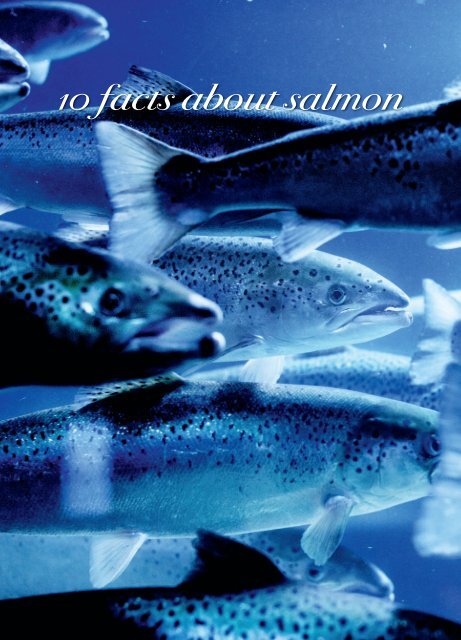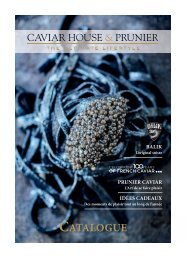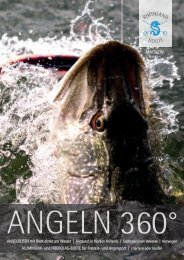Caviar House & Prunier Catalog 2020
Create successful ePaper yourself
Turn your PDF publications into a flip-book with our unique Google optimized e-Paper software.
10 facts about salmon<br />
1.<br />
Salmon myth<br />
Mythology, folk customs and art reflect how man’s imagination<br />
has always been inspired by the extraordinary life of salmon.<br />
There is also a beautiful, but unlikely story about the origin of<br />
the name: Caesar’s soldiers first saw salmon jump in distant<br />
Germania and called them salmo from Latin salire (= jump).<br />
3.<br />
3. Salty-Sweet Life<br />
2.<br />
Red or rosé?<br />
The colour of the salmon is not an indication of quality per se.<br />
It is determined by the type of salmon, fishing area and feed.<br />
The preferences are also very different according to nationality:<br />
the Japanese, for example, prefer the dark red of sockeye,<br />
while Western Europeans particularly appreciate the rich rosé of<br />
salmo salar.<br />
4.<br />
Bounce<br />
10 FACTS ABOUT SALMON<br />
Most salmon species are anadromous fish - they live in both<br />
salt and fresh water. The Atlantic salmon are born in sweet<br />
river water and go downstream to the open sea at the age of<br />
about 10–12 months. A few years later the salmon return to<br />
their native rivers. They cover huge distances to reproduce in<br />
fresh water. This is how the salmon’s life cycle begins.<br />
With the reproductive-induced migration upstream, the salmon<br />
can show the art, for which they are particularly known. Thanks<br />
to an ingenious jumping technique, they overcome metre-high<br />
obstacles, such as weirs or waterfalls. For this enormous physical<br />
achievement, the salmon stops eating in the river and feeds<br />
exclusively on its fat reserves. So it happens, unfortunately,<br />
that less than a tenth of all Atlantic salmon survive the<br />
strenuous journey and return to the sea after fertilizing.<br />
5. 6.<br />
Risks of salmon life<br />
Salmon is healthy<br />
In wild salmon, about 5000 eggs are needed for 5 salmon to<br />
grow in the ocean. Of these, only one pair reaches the river to<br />
spawn, ensuring survival.<br />
The World Health Organization and the Norwegian Health<br />
Authority recommend 2 to 3 main meals with fish per week,<br />
half of which should be fatty fish such as salmon. Salmon is<br />
therefore not only a delicious delicacy, but also has a pleasant<br />
side effect, to do good for our health.<br />
7.<br />
Calorie counter<br />
8.<br />
The North<br />
Salmon is a particularly valuable food because of its composition.<br />
More or less calories are mainly due to the different fat<br />
contents of the salmon species. In addition, the fat content of<br />
each individual salmon varies according to season and diet.<br />
Young salmon also usually have a higher fat content than adult<br />
salmon.<br />
The most important catching and trading nations were the<br />
Scandinavian countries and Russia around the Baltic Sea, but<br />
especially England, Scotland and Ireland. Looking at current<br />
global salmon production figures, Norway leads the market<br />
ahead of Chile and the UK.<br />
9.<br />
Salmon<br />
eats sparingly<br />
10.<br />
Breeding salmon<br />
has place<br />
A farmed salmon from 2.5 to 5.5 kg in weight, eats an average<br />
of 22 grams of feed per day. With 100 kg of feed, a weight<br />
gain of approx. 65 kg can be achieved for salmon. Compared to<br />
other animals this is very little. With the same amount of feed,<br />
pigs gain approx. 13 kg in weight and sheep only approx. 1.2 kg.<br />
Norwegian farmed salmon has a lot of freedom. The rule laid<br />
down by the law in Norway specifies the following ratio<br />
between fish and water per net enclosure: 2.5 percent fish<br />
with 97.5 percent water.<br />
37















